Page 15 of 22
Re: CRINCH! The Crab of the Day!
Posted: Sun Dec 04, 2016 1:30 pm
by Nezumiiro

Photo credit:
Izuzuki Diver.CRINCH! #CrabOfTheDay for 11/29/2016: Aniculus miyakei, or the Hondooniyadokari (ホンドオニヤドカリ) Meaning "Chief Oni (a type of Japanese Demon) Hermit Crab," is a great family Diogenidae (Lefthanded hermit crabs) species, native to East Asia. Covered in bristly setae, used for the purpose of detritus capture, these nocturnal shallow water dwellers will nevertheless go after live food too- such as Tuban Snails and the like. Bright red to dark brown in color, these intertidal Hermit Crabs are widely sold in aquarium stores in Mainland Japan from Niigata and Tokyo Bay to Kagoshima Bay, Taiwan.
http://www.marinespecies.org/aphia.php? ... &id=367404http://www.eol.org/pages/3109856/overview
Re: CRINCH! The Crab of the Day!
Posted: Sun Dec 04, 2016 1:32 pm
by Nezumiiro

Photo credit:
Usujiri.CRINCH! #CrabOfTheDay for 12/01/2016: Hapalogaster dentata, or The Ibotokagani (イボトゲガニ) is a Far Asian East /North Pacific species of hardshell family Hapalogastridae Anomurian, MAINLY found in Japanese waters. This mid-depth (100m – 200m) ‘false crab’ has a brown-to-beige carapace, covered with numerous tubercles, and the large chelipeds associated with “crab cousins” such as porcelain crabs. Oddly enough, while the outermost texture of this crab’s shell is heavy, the underside near the stomach is ‘puffy’ and feels surprisingly squishy!
http://www.marinespecies.org/aphia.php? ... &id=590109http://www.eol.org/pages/4255540/overview
Re: CRINCH! The Crab of the Day!
Posted: Sun Dec 04, 2016 1:33 pm
by Nezumiiro

Photo credit:
Jim Anderson.CRINCH! #CrabOfTheDay for 12/02/2016: Xenocarcinus conicus, or The Conical Spider Crab is a bizarre looking species of coral crab found in the Western Central Pacific, namely New Caledonia, Oceana, and Southeast Asia, living on dendritic soft corals such as Dendronephthya hembrichi, and fan gorgonians. This family Epialtide crab has a distinct elongate oval shaped carapace with somewhat depressed/poorly defined lobes. While this species’ chelipeds are not stouter and longer than any of the ambulatory legs, it chooses camouflage over combat; it can camouflage almost perfectly against the gorgonians it lives on. Oddly enough, X. conicus’ body shape may be a development against predators that prefer to eat more "crab shaped" prey.
http://www.marinespecies.org/aphia.php? ... &id=441504http://www.eol.org/pages/4315936/overview
Re: CRINCH! The Crab of the Day!
Posted: Sun Dec 04, 2016 2:15 pm
by Nezumiiro

Photo credit:
Almeida, Bezerra, and Guerrazzi.CRINCH! #CrabOfTheDay for 12/04/2016: Sotoplax robertsi, affectionately called “Robert’s Goneplacid Crab,” is a unique Superfamily Goneplacoidea/ Family Sotoplacidae species found ONLY in the Gulf of Mexico and the Northern-most coasts of Brazil. One of only two members of the relatively young Genus Sotoplax, S. robertsi is characterized by a suite of characteristics such as distinct thoracic sternum and a ‘penis shield’ on the male abdomen. These small goneplacids crabs were first catalogued by Guinot in ’84 despite being first collected by Dr. L.A. Soto during the exploration of the northeastern continental shelf of the Gulf of Mexico, from 1970-1971.
http://www.marinespecies.org/aphia.php? ... &id=422064http://www.eol.org/pages/312873/overview
Re: CRINCH! The Crab of the Day!
Posted: Mon Dec 05, 2016 11:42 pm
by Nezumiiro

Photo credit:
Gerardo Marrón.CRINCH! #CrabOfTheDay for 12/05/2016: Callinectes bellicosus, or The Warrior Swimming Crab (called the "Cortez Swimming Crab" in some locales.) is a family Portunidae species of blue swimmer looking VERY SIMILAR to the common Atlantic/Chesapeake Blue Crab- (Callinectes sapidus) minus the red tipped claws. Native to the warm waters and shorelines in Mexico, namely the Mexican Pacific and The Gulf of California, these crabs, while not routinely farmed, (outside of one season fishery) can be cooked and eaten in the exact same manner as any other edible swimmer!
http://www.marinespecies.org/aphia.php? ... &id=442767https://www.itis.gov/servlet/SingleRpt/ ... 98702#null
Re: CRINCH! The Crab of the Day!
Posted: Tue Dec 06, 2016 8:26 pm
by Nezumiiro

Photo credit:
Hans Hillewaert.CRINCH! #CrabOfTheDay for 12/05/2016: Gecarcinus lateralis, or The Blackback Land Crab (sometimes called the San Juan Crab) is a shoreline species of semi-terrestrial, family Gecarcinidae crab found along the Atlantic coast from South Padre Island, Texas to Macuto, Venezuela- It also inhabits the Florida Keys and the islands of the Caribbean. Generally living no further than 30 ft from the high-tide mark, G. lateralis looks predominantly for herbivorous meals, but will jack up and eat small animals whenever possible. Called “Jueyes” in Puerto Rico, these crabs are the main component in a popular national dish called “arroz con hueyes.” (Rice with crab meat!)
http://www.marinespecies.org/aphia.php? ... &id=422184http://eol.org/pages/344749/overview
Re: CRINCH! The Crab of the Day!
Posted: Wed Dec 07, 2016 8:15 pm
by Nezumiiro

Photo credit:
Carmona-Suarez.CRINCH! #CrabOfTheDay for 12/07/2016: Mithrax aculeatus, called The Paved Clinging Crab is a family Mithracidae species found in the Western Atlantic Ocean, including the Caribbean. This shallow-water (0-100 m) dweller picks through coral beds and rubbles for tasty snacks, it’s variegate spines and granular (looks PAVED!) carapace providing protection from the parrotfish and other predators that share its habitat. M. aculeatus persists in a state of almost near-permanent taxonomical review; having been formerly labeled Mithrax verrucosus AND Mithrax pilosus!
http://www.marinespecies.org/aphia.php? ... &id=442119 https://www.itis.gov/servlet/SingleRpt/ ... 98529#null
Re: CRINCH! The Crab of the Day!
Posted: Thu Dec 08, 2016 3:55 pm
by Nezumiiro

Photo credit:
Centro Sub Monte Conero.CRINCH! #CrabOfTheDay for 12/08/2016: Scyllarus arctus, or The European Locust Lobster is a classic family Scyllaridae "Slipper Lobster," found scuttling around the mud, rock, and coral in the Mediterranean Sea, Eastern Atlantic Ocean, English Channel, and Bay of Biscay. These fabulously orange-eyed nippers are SUPER DELICIOUS and somewhat sustainable as their ecological characteristics make them resistant to die-off extinction and as a whole, Slipper Lobsters are highly fecund with well connected populations via long-lived larvae.
http://www.marinespecies.org/aphia.php? ... &id=107709http://species-identification.org/speci ... ers&id=198
Re: CRINCH! The Crab of the Day!
Posted: Sat Dec 10, 2016 12:55 am
by Nezumiiro

Photo credit:
Alexander Semenov.CRINCH! #CrabOfTheDay for 12/09/2016: Glebocarcinus amphioetus, or The Bigtooth Rock Crab is a family Cancridae species, found in a variety of locales, both Atlantic (around Russia and Northeastern Europe) and Pacific. (New Zealand through Japan, California, ) A member genus having ONLY one other member: Glebocarcinus oregonensis, G. amphioetus has the classic “Carcinid” saw-edged oval body shape. This intertidal crab also has the ‘upturned’ chelipeds associated with other related crabs.
http://www.marinespecies.org/aphia.php? ... &id=440383http://species-identification.org/speci ... an&id=1045
Re: CRINCH! The Crab of the Day!
Posted: Sun Dec 11, 2016 12:50 pm
by Nezumiiro

Photo credit:
Marlin Harms.CRINCH! #CrabOfTheDay for 12/10/2016: Petrolisthes manimaculis, or The Chocolate Porcelain Crab is a BEAUTIFUL 'blue-speckles-on-brown' example of a Family Porcellanidae species. Thriving in the California Pacific waters from Baja to at least Baker Beach and Indian Beach in the North, this ornate species filter feeds on detritus and lives best in small knit communities with a variety of other sea life including sea urchins, soft corals, tube worms, sponges, and hydrozoans. Like with other porcelain crabs, P. manimaculis uses almost hair-trigger “Limb Autotomy” as a highly effective escape mechanism. By detaching a cheliped that keeps twitching and flexing, the predator will go for it first rather than the crab, which quietly slinks away. Reliance on autotomy as a primary escape mechanism is particularly common in suspension-feeding crabs that do not use their chelipeds for feeding.
http://www.marinespecies.org/aphia.php? ... &id=431859http://www.inaturalist.org/taxa/53624-P ... animaculis
Re: CRINCH! The Crab of the Day!
Posted: Mon Dec 12, 2016 8:06 pm
by Nezumiiro
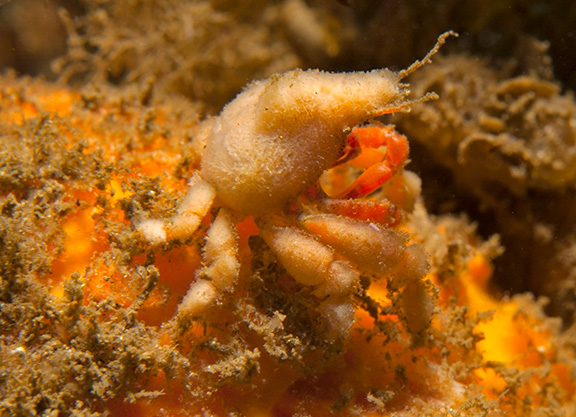
Photo credit:
Phil Garner.
CRINCH! #CrabOfTheDay for 12/12/2016: Pelia tumida, or The Dwarf Teardrop Crab is a secretive little family Epialtidae species found in the East Pacific. This tiny decorator crab survives in its ‘crab-eat-crab’ world by using a three-fold decoration scheme: First, the disgusting taste of its chosen sponge decorations appears to deter some feeding by predatory fish. Second, selective decoration with chemically noxious bryozoans stops a variety of fish and invertebrates such as snails and octopi from snacking on it. Finally, the use of anemones, which have stinging nematocysts, may deter crab and other crustacean predators. This lil’ mustard-yellow species is a one crab army!
http://www.marinespecies.org/aphia.php? ... &id=441652http://www.eol.org/pages/343931/overview
Re: CRINCH! The Crab of the Day!
Posted: Tue Dec 13, 2016 11:56 pm
by Nezumiiro
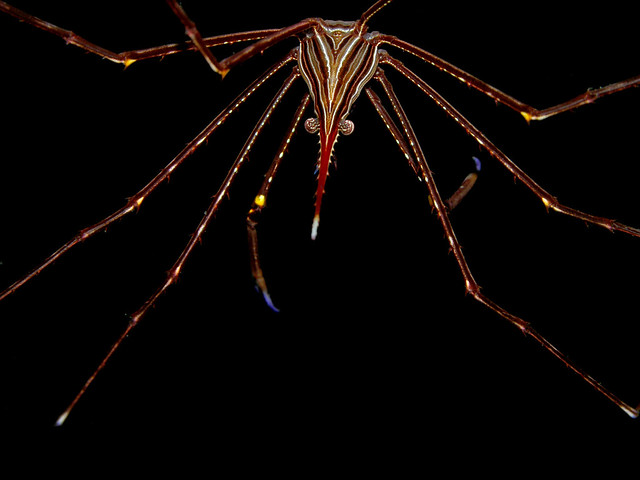
Photo credit:
Arthur Anker.CRINCH! #CrabOfTheDay for 12/13/2016: Stenorhynchus lanceolatus, or The Eastern Atlantic Arrow Crab is a wild looking family Inachidae species found on the Northwest coastal reefs of Africa; namely Guinea-Bissau, the Madeiran Exclusive Economic Zone, and the Canary Islands. This bright Arrow Crab has a small, slightly flattened body with orange, beige, yellow, and red stripes. Its legs are very thin and very long, measuring about three times the size of the body. Both carnivores AND detritivores, S. lanceolatus crabs prefer to pick morsels off of rocks and corals, but won’t hesitate to JACK UP an easy living meal- ESPECIALY when kept in reef tanks!
Stenorhynchus lanceolatus very often lives close to the giant anemone, Telmatactis cricoides.
http://www.marinespecies.org/aphia.php? ... &id=107362http://www.eol.org/pages/12165128/overview
Re: CRINCH! The Crab of the Day!
Posted: Thu Dec 15, 2016 12:50 am
by Nezumiiro

Photo credit:
J. Poupin.CRINCH! #CrabOfTheDay for 12/13/2016: Pachygrapsus planifrons, or The Squarefront Shore Crab is a small, semi-terrestrial species of Indo-Pacific, Family Grapsidae crab found in unique microclimes such as those located in the Mozambique Channel, the Comoros, French Polynesia, Wallis and Futuna, Hawaii, the Andaman and Nicobar Islands, the Maldive and Laccadive Archipelagoes, and the Marquesas. This small crab has a trapezoidal carapace less than an inch wide with distinctive white spots on its inner sides. Additionally, the crabs of Genus Pachygraspus are said to be “polyphyletic” or were once several distinct groups that genetically re-converged over time.
"Planifrons" is a Latin term, used almost exclusively as a taxonomic epithet, from planus ("flat, level") + frōns ("forehead, front") ie; having a flat front or forehead!
http://www.marinespecies.org/aphia.php? ... &id=207538http://www.eol.org/pages/321437/overview
Re: CRINCH! The Crab of the Day!
Posted: Sat Dec 17, 2016 11:21 am
by Nezumiiro

Photo credit:
J. Poupin.CRINCH! #CrabOfTheDay for 12/16/2016: Dardanus sanguinocarpus, or The Bloody Hermit is a beautiful family Diogenidae crab-cousin, found predominantly in the South Pacific- namely French Polynesia, Hawaii, Midway Atoll, the Marquesas, and the French Frigate Shoals. Generally, these critters hang out in the shallow subtidal areas to at around the 20 m depth zone, though it isn’t unusual to see Bloody Hermits in tide pools. A reef-rubble associated animal, D. sanguinocarpus lives in close proximity (allied) with a variety of other species, including various red algae, which may have contributed to its namesake!
Fun Fact: Bloody Hermits are called "Unauna" in native Hawaiian!
http://www.marinespecies.org/aphia.php? ... &id=367592http://www.eol.org/pages/1038119/overview
Re: CRINCH! The Crab of the Day!
Posted: Sun Dec 18, 2016 5:29 pm
by Nezumiiro
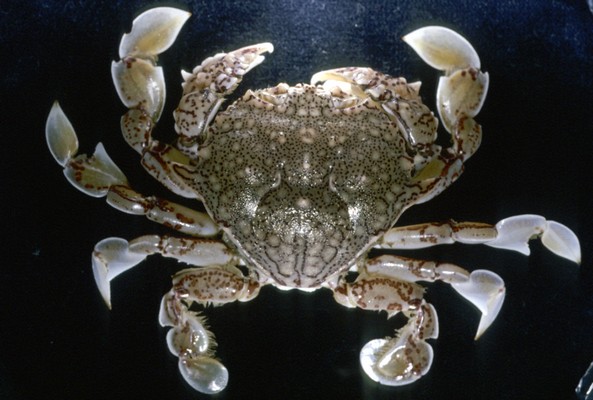
Photo credit:
IRD, Laboute.CRINCH! #CrabOfTheDay for 12/17/2016: Ashtoret picta, or The Spotted Moon Crab is a glorious South Pacific and occidental Mediterranean species of Family Matutidae tidal crab. These beautiful Polynesian pinchers are omnivorous feeders in the soft mud and gravel beds of the 100m +/- depth zone.Named after "Ashtoret," the ancient Phoenician goddess of reproduction and water, but it’s also of taxonomic note that the name "picta" is a Latin suffix meaning ‘markings or spots.’
http://www.marinespecies.org/aphia.php? ... &id=440346http://www.eol.org/pages/4270568/overview
Re: CRINCH! The Crab of the Day!
Posted: Sun Dec 18, 2016 5:30 pm
by Nezumiiro
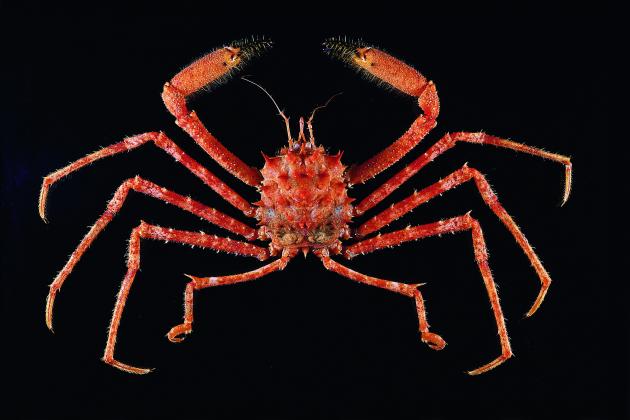
Photo credit:
Tin-Yam Chan.CRINCH! #CrabOfTheDay for 12/17/2016: Moloha majora, or The Great Mahogany Crab (大摩羅蟹 in Chinese) is a fantastic ‘primitive crab’ found in various parts of the Pacific Ocean: from French Polynesia through Greater Asia, southward to New Caledonia. This long limbed, spiky family Homolidae species is technically speaking, a carrier crab (Just check out the last pair walking legs!) which re-developed the habit of ‘not carrying stuff.’ Colored a pretty perfect shade of reddish-orange, M. majora blends in pretty well among the red algae and coral found in the soft substrates at 100 m – 310 m depth.
http://www.marinespecies.org/aphia.php? ... &id=440206http://species-identification.org/speci ... pan&id=640
Re: CRINCH! The Crab of the Day!
Posted: Mon Dec 19, 2016 11:57 pm
by Nezumiiro

Photo credit:
G. & Ph. Poppe, 2011.CRINCH! #CrabOfTheDay for 12/19/2016: Rhinolambrus contrarius, or The Giant Elbow Crab is a BUFF LOOKING family Parthenopidae monster, found from Hawaii Southward to Australia, Westward to Japan, through the East Indies, and across the Indian Ocean to the coast of Africa. Its massive size aside, (As far as elbow crabs go!) R. contrarius has even MORE pronounced chelipeds with prominent spines. The terror of the Sublittoral silt beds, Giant Elbow Crabs define “crabbiness” by their aggressive nature.
http://www.marinespecies.org/aphia.php? ... &id=442321http://www.species-identification.org/s ... an&id=1014http://www.veoh.com/watch/v1159909rJCYf7tD
Re: CRINCH! The Crab of the Day!
Posted: Tue Dec 20, 2016 8:07 pm
by Nezumiiro

Photo credit:
J. Poupin.CRINCH! #CrabOfTheDay for 12/20/2016: Calcinus latens, Or The Hidden Hermit is a beautifully colored family Diogenidae species found pretty widely worldwide. Seriously, name a not frozen coast, and you’ll find C. latens! This intertidal hermit was nicknamed “Hidden” for its proclivity of choosing shells far bigger than its body- effectively making it harder to see! Hidden Hermits are frequently found associated with hard corals of the genus’s Pocillopora and Acropora, and diet wise, are true omnivores; alguivorous, carnivorous, necrophagus, and detritivorus, and opportunity hunters! Though rare in captivity, these crabs are nevertheless sought after for their amazing coloration- bluish eyes, yellow antennae, purple ringed ambulatory legs, and olive green claws.
Photo credit: Dave Burdick, guamreeflife.com.
http://www.marinespecies.org/aphia.php? ... &id=208677http://eol.org/pages/317383/overview
Re: CRINCH! The Crab of the Day!
Posted: Fri Dec 23, 2016 9:48 am
by Nezumiiro

Photo credit:
G. & Ph. Poppe, 2006.CRINCH! #CrabOfTheDay for 12/22/2016: Eurynome aspera, or the Eastern Strawberry Crab is a widely distributed Majidae/Majinae species, found in the Mediterranean, European Seas, North Atlantic, MENA, Levant, North Africa, and North Europe/Russia. This weird looking strawberry shaped/colored thing seldom gets bigger than 2cm in length; due to its diminutive size, instead of fighting, E. aspera chooses camouflage as a survival tactic. Hanging out in lower shores/beds at the 180 m or deeper range, Eastern Strawberries only MAJOR threat is the entoniscid parasite, Entionella monensis.
http://www.marinespecies.org/aphia.php? ... &id=107318http://species-identification.org/speci ... cea&id=209
Re: CRINCH! The Crab of the Day!
Posted: Wed Dec 28, 2016 7:22 pm
by Nezumiiro

Photo credit:
John H. Moore.CRINCH! #CrabOfTheDay for 12/27/2016: Pugettia dalli, or The Spined Kelp Crab is a distinct family Epialtidae species found in the East Pacific, namely Southern California through Baja. Previously known as Channel Island Kelp Crab and the Whiteknee Kelp Crab, this Rathbun-catologued crustacean is one of the smallest living kelp crabs. Hiding among the swaying vegetation in eel grass beds, these tiny intertidal crabs are herbivores most of the time, nipping off bits of plants and algae. When the algae die back during winter, P. dalli will turn to an animal diet, including small mussels and barnacles as well as smaller creatures such as bryozoans and hydroids; an animal that can change its diet seasonally is always at an advantage.
http://www.marinespecies.org/aphia.php? ... &id=441476http://eol.org/pages/313129/overview
Re: CRINCH! The Crab of the Day!
Posted: Sat Dec 31, 2016 4:14 pm
by Nezumiiro

Photo credit:
Chris Lukhaup.
CRINCH! #CrabOfTheDay for 12/29/2016: Uca subcylindrica, called The Laguna Madre Fiddler is a super adaptable species of crab with the geographic range of the Western Atlantic, namely the Gulf of Mexico. (Texas/Northern Mexico) Named for the mud flats of the hypersaline Lagoon Madre, (Look it up!) these large clawed family Ocypodidae monsters have highly adaptable zoea, capable of dealing with lack of food and salinity extremes. In their semi-arid habitats, where nursery areas are temporary rainfall puddles, several characteristics of the larvae and early postlarvae stages promote high survivorship in these extreme environments.
http://www.marinespecies.org/aphia.php? ... &id=378363http://www.eol.org/pages/343568/overview
Re: CRINCH! The Crab of the Day!
Posted: Sat Dec 31, 2016 4:15 pm
by Nezumiiro

Photo credit:
Brian Mayes.CRINCH! #CrabOfTheDay for 12/30/2016: The Swollen Soft Coral Crab (Calvactaea tumida) is a pretty sweet looking species of crabs in the family Xanthidae, (The only species in the genus Calvactaea!) found primarily off the coast of New South Wales, Australia, as well as, Sri Lanka, China, Taiwan, and Japan. This wooly, globe-shaped pink crab is a detritus eater; its chelipeds better adapted for clinging and picking things up than fighting. These tiny guys are usually (though infrequently) photographed living on a rather narrow range of regional dendronephtyeid soft corals, though C. tumida is also regularly seen among the invertebrate life that frequents underwater wrecks.
http://www.marinespecies.org/aphia.php? ... &id=444351http://www.species-identification.org/s ... an&id=1193
Re: CRINCH! The Crab of the Day!
Posted: Sat Dec 31, 2016 4:16 pm
by Nezumiiro
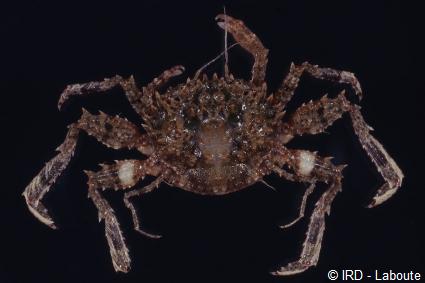
Photo credit:
IRD - Laboute.CRINCH! #CrabOfTheDay for 12/31/2016: Pseudopalicus investigatoris, or The Investigator Stilt Crab is a rarely witnessed family Palicidae crab hailing from Greater Oceana/NCE, Australia and New Zealand, and East Asia. This crab has a flattened, roughly circular body with 4 teeth and 8-10 tubercles, from which three pairs of spindly legs project. A fourth pair of legs is much reduced and has a “filamentous” aspect, or is used for something other than walking! Investigator Stilt Crabs are found on the deep-sea floor, (generally depths greater than 150 m) often on muddy substrates, where they eke out a living as scavengers.
http://www.marinespecies.org/aphia.php? ... &id=442214https://inpn.mnhn.fr/espece/cd_nom/596438
Re: CRINCH! The Crab of the Day!
Posted: Sun Jan 01, 2017 3:01 pm
by Nezumiiro

Photo credit:
Luc Bourdil.CRINCH! #CrabOfTheDay for 01/01/2017: Zenopontonia noverca, or The Rounded Sea Star Shrimp- also called the CELEBRATION SHRIMP is a beautifully festive Indo-West Pacific species of family Palaemonidae 'Caridean' Shrimp. Maxing out at no greater than 3/8 inches (1.1 cm) in length, this tiny crustacean lives commensally on the large echinoderm (Asteroidea) Sea Stars of Australia, The Indian Ocean, The Red Sea, Tanzania, and New Caledonia. These shrimps keep their host animals free of algae blooms and smaller, parasitic crustaceans- and in return, get a really safe place to live! Additionally, depending on the color or patterns of the Stars they live on, young Z. noverca will develop a more complimentary color of their own for a more complete camouflage strategy.
http://www.marinespecies.org/aphia.php? ... &id=220203http://www.eol.org/pages/319706/overview
Re: CRINCH! The Crab of the Day!
Posted: Sun Jan 01, 2017 3:03 pm
by Nezumiiro

Photo credit:
#CrabOfTheDay Adam.CRINCH! BONUS #CrabOfTheDay for 01/01/2017: Here at #CrabOfTheDay, we just want to wish y’all an illuminated CRABBY NEW YEAR! Light up your crab lamps and steam up some Dungeness! MAKE THE MOST OF IT and KICK IT OFF WITH A PROPER CRINCH!























